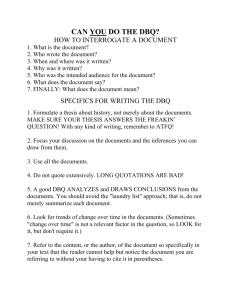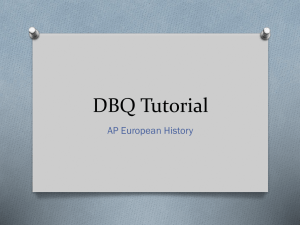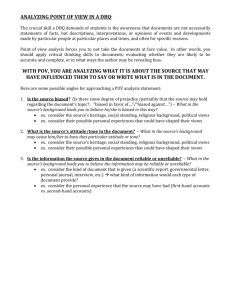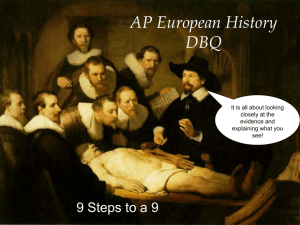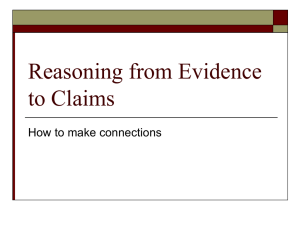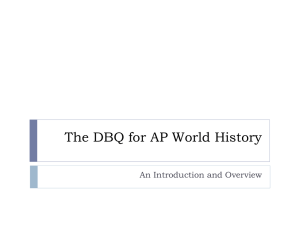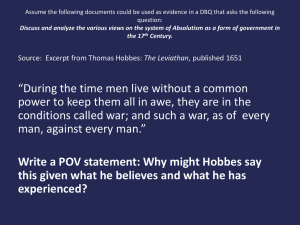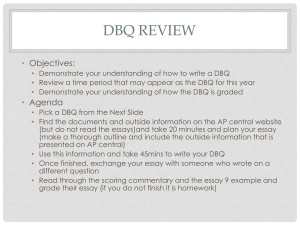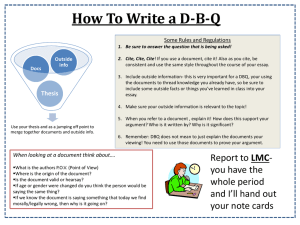Even YOU can do a DBQ!
advertisement
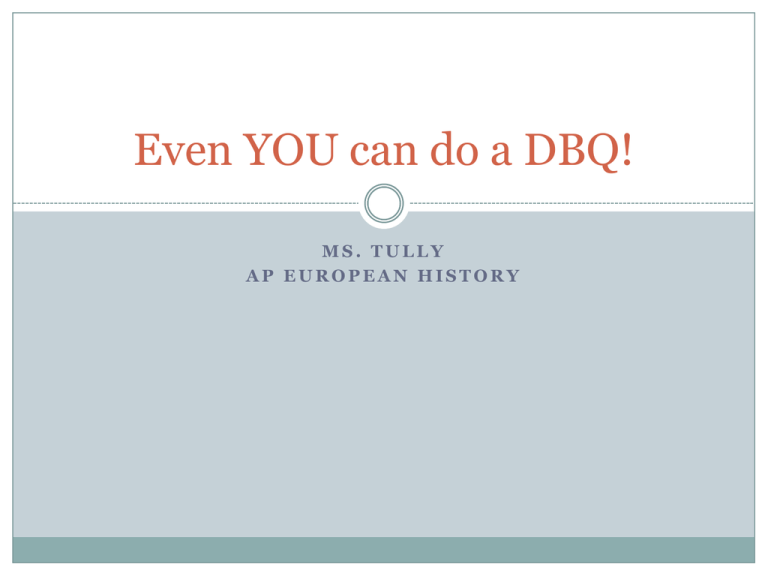
Even YOU can do a DBQ! MS. TULLY AP EUROPEAN HISTORY Introductory Paragraph (4-6 sent.) Establish a TIME and PLACE Create a clear THESIS STATEMENT Allude to the SUB-TOPICS or categories you will use to discuss your thesis statement Focus on the question at hand, do not begin with a “flowery” sentence Body Paragraphs (8-12 sent.) Identify your sub-topic or category in your FIRST sentence Include the documents that are relevant to support the ideas in your paragraph Use the MAJORITY of the documents provided (70%) Be sure to indicate POV/Bias Bring in supportive outside information – This is critical! Why were these documents selected? Questions to Ask Yourself About the Documents Attribution – who is this person? Why might they be significant? What is the POV of the author? How reliable and how accurate is the source? What is the tone or intent of the document’s author? What other useful information does this document call to mind? Use all available clues! Demonstrating POV/Bias Attribution: cite the author by name, title, or position if possible Why is this person and document selected? How does it help me answer the question? Examples: “Bartolome de las Casas, a militant frier, wrote…” Demonstrating POV/Bias Authorial Point-of-View: You show awareness that the gender, occupation, class, religion, nationality, political position or ethnic identity of the author could influence his/her views. How does this apply to the question? Why has the author written what he/she has? Example: Jacque Ciompi, as a French peasant, enjoyed seeing Marie Antoinette guillotined, since as a peasant and member of the third estate he was in favor of the French Revolution. Demonstrating POV/Bias Reliability and accuracy of each source referenced: You examine a source for its reliability and accuracy by questioning if the author of the document would be in a position to be accurate. How might this help you answer the question? Example: John Martin’s letter home about the Christmas celebrations in Germany is probably inaccurate since John Martin is an Englishman and would not understand all the local traditions and customs of Germans. Demonstrating POV/Bias Tone or Intent of the Author: You analyze the text of a document to determine its tone (satire, irony, indirect commentary, etc…) or the intent of the author. Especially useful for visual documents, like art work or political cartoons. Example: Pieter Brueghel painted “The Harvesters” to show his audience the struggle and toils that the peasants went through on a daily basis. Demonstrating POV/Bias Grouping of Docs. By Author: You show a certain awareness that certain types of authors, simply by their authorship, will express similar views when you group documents by type of author. Example: The government officials of Britain, France, and Spain all believed that the peasants were being violent, unruly, and committing sin by revolting. How to Reference a Document in Your Essay Baldassare Castiglione, in The Handbook of the Courtier, said: “………………….” Erasmus of Rotterdam, a northern Christian humanist, agreed with… The 19th century historian, Jacob Burkhardt, felt that …………………. (Doc. 9) NEVER begin with “In Document 9….” The Concluding Paragraph (3-4 sent.) Start with a “concluding” phrase. Restate your thesis statement, a bit differently. Put your essay answer in a larger historical perspective: End of some trend/movements/ideas, etc… Beginning of some trend/movements/ideas, etc… End of one, beginning of another. Do NOT end on the note that this is the reason we are where we are today! The Steps to a DBQ 1. Identify how each document relates to the question. What is its PERSIA theme? Doc. 1: Parliament of England, Act of Supremacy, 1559 Theme: Political The Steps to a DBQ 2. Group the documents into as many groupings as you can. A document may be used twice, but it counted only once. A group must include more than one document. Misogyny: 1, 2, 5 Propaganda: 8, 9, 11, 12 Religious Figures: 1, 2, 3, 5, 7, 9 The Steps to a DBQ 3. Using the groupings you created, identify three or four groupings you will use in your DBQ. Be sure that the groups you choose go together – using them together in an essay must make sense: Group 1: Group 2: Group 3: Group 4: The Steps to a DBQ 4. Introduction – Identify and define the main subject of your essay. When writing your thesis statement, remember that each of the groups you created will be one of your body paragraphs. A. Intro sentence: B. Thesis statement: The Steps to a DBQ 5. Body Paragraphs – what is the theme of this group? A. Topic Sentence: B. Identify relevant, important, and specific items of historical evidence. How does it support your thesis? Evidence #1: Connection to topic/thesis: Evidence #2: Connection: The Steps of a DBQ 6. POV in Paragraph POV #1 w/ Doc.# As a/an , because he/she/they sought to ‘s POV is biased Thus this document is not/reliable because the author likely exaggerated . Concluding Sentence. The Steps of a DBQ 7. Conclusion and Review: Restate thesis At least one additional sentence summarizing essay Re-read essay! Does your thesis still reflect your essay? Do your topic sentences reflect the paragraphs? Grammar, spelling, and legibility 3-5 mins, max (you still have FRQ’s…)
